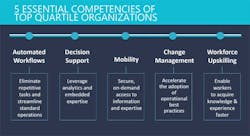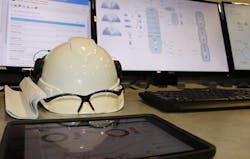Train of Thought: Automation Leader's Advice to Keep Manufacturing on Right Track
When he took over as president of Emerson Electric [IW500/71] Oct. 1, Mike Train started with a full head of steam.
First, he was officially introduced on stage at the Emerson Global Users Exchange, a gathering in San Antonio of 3,500 of the automation solutions provider's customers, from gas & oil to food & beverage. They made the trip to pick up the latest insights to aid in their digital transformation. This could be to make energy extraction and use more efficient, improve the cold chain, or making sure food stays safe, ensuring medicine gets transported properly, and optimizing buildings' climate control systems. Train calls them all "noble causes that we touch."
A startling revelation Train shared was that only 20% of industry leaders had a clear vision for this transformation, though 90% believed it to be important. A few hours later, his successor at Emerson Automation Solutions, Lal Karsanbhai, outlined a detailed roadmap they are now offering to connect applications and businesses, and reach "top quartile performance."
That morning presentation kicked off with a slick short film about two kids and their technologically savvy approach to the sidewalk lemonade processing industry. It's clear Emerson takes the skills gap serious enough so to make it the opening salvo of their annual event, and the tack of eliciting a childlike wonder to address it is the kind of thing we'd come to expect from General Electric a few years back when they launched Predix. (This film's score, awesomely cheesy 1980s synth music, was a pleasant new touch).
It should come as no surprise then, that Train kept the day's momentum going by hopping on a plane back to home base in St. Louis for a board meeting. The next day, Emerson announced their deal for GE's Intelligent Platforms business and its PLC technology, which complements Emerson's distributed control systems. Essentially what this does is fill a critical gap in their machine control capabilities, positioning Emerson as a power player in automating both process and discrete manufacturing. A year ago, Emerson went hard at Rockwell Automation to achieve the same goal before being rebuffed.
"It has been pretty clear over the past year that we had interest in the PLC space," Train says. "Intelligent Platforms fits well into our Automation Solutions strategy to serve customers across the process, hybrid and discrete markets and allows us to now offer best-fit control solutions."
The new president, who replaces the retired Edward L. Monser, previously conducted Emerson's Automation Solutions business, which generated $9 billion in revenue annually and employed 55,000 people. Now he's helping CEO David Farr oversee a growing business (5.11% revenue growth) that earns $15 billion a year and employs 76,000 globally.
In between the big announcements, Train sat down with us to talk about the new role, and the new responsibilities he feels he has not only to Emerson, but to partners, customers and the next generation of manufacturers.
John Hitch: What are some of the industry challenges you are inheriting?
Mike Train: The big themes are managing around global activities. In the short term there's been the trade tension discussions. We have been caught in the middle of some of those things and are trying to advocate for some of those to settle out. We've started to see some of those settle out with the United States-Mexico-Canada Agreement.
In the long term, demographics are weighing heavily on a lot of these societies. The Baby Boomers are retiring so we are losing a lot of experience, a lot of the history and sources behind the reasons why do things.
We're going to have to fill some of those skills gaps going forward, and I believe that will take changing the nature of the work. In individual context, how do you make that change?
We need people who have permission to change, the mandate to change. We support those efforts through the automation context and by working with our customers. Automation can fill some of the gaps. Solve some of the equations. How do we make the work more knowledge content based, so you get more productivity, efficiency and impact from your people?
It's something we face in our own business. There's high competition for resources and people. First, we need to attract them to our industry, and then over to Emerson.
JH: The video you played of the kids using somewhat advanced manufacturing for their lemonade business was clever and funny, but touches on a serious subject: if we don’t get the next generation to learn these STEM skills, there might never be an Industry 5.0. What's your approach to this impending skills gap?
MT: If they don’t learn these skills, we will all collectively come up short. We are trying to advocate in the communities we can touch, and we can touch communities on a global scale. We're trying to open up the eyeballs of the young, engaging with schools, giving them curriculums, opening up our facilities to give them a perspective on what we do. Sometimes we're in a neighborhood, but the community doesn't know what happens within our four walls. We want to share those things.
The video is all about curiosity and enabling that. Collectively, industry leaders need to be out there pushing and advocating an understanding of what these careers could be, and make sure the educational track is getting to them and reaching them, preparing them.
JH: The problem doesn't seem to be getting kids excited about robots and tech. What seems to be missing is everyone involved in manufacturing, from the biggest OEM to small machine shops investing in real solutions. What do you say to that?
MT: Let's do it together. We have to do it together. In my own personal case, I was a complete failure. I have five children, three girls and two boys. The three girls were very accomplished in school, very capable—none of them went the STEM direction. That was a failure on me. Somehow, I should have made sure they had a good perspective on it and what the opportunities were. They have all gone on to great careers—and my one daughter who is a lawyer circled back to the technology realm and is now working with Magic Leap.
I feel like they found it eventually, we all need to do a better job showing how noble these professions are.
JH: Where's the disconnect?
MT: We've got to reshape the whole ecosystem, from education all the way through. Engineering education is boring. I challenge my university friends, and you can write me hate mail, but I always tell people, get into engineering, get through those four years. Because when you come out, what you do every day is totally different. Hopefully, what we can do is make the education more appealing and more interesting, so it doesn't feel like you have to suffer through those three or four years. I have noticed educators are now picking up different ways of engaging and exposing students, taking on the mission of preparing these people for what they need to become.
Welding is awesome. Computer-aided machining is awesome. They make real things.
Everyone has to find their passion. We're very engaged with technical trade schools here in St. Louis, like Ranken Technical College. They're very fertile, they're innovating like crazy, maybe even more so than the four-year universities. And really trying to change their programming, really trying to hit their mark. And the average starting pay (up to $60,000) is higher than the four-year universities in Missouri.
Emerson is providing $1.75 million to fund scholarships for students from north St. Louis County to receive career and technical education. To date, this has helped more than 200 students from North St. Louis pursue vocation training at Ranken.
JH: There's also the matter of improving communities. A focus on the trades should decrease poverty and crime by offering better economic opportunities. Wouldn't that ostensibly fix several problems at once?
MT: We're based in Ferguson. We took on a personal challenge after the tensions to be involved. We've worked with educators from elementary to the high school, trying to get people from the high school to trade schools or universities. We've created internship programs on our campus to provide experiences and show what the possibilities are and motivating [students from Ferguson] to move forward and seek more education. And we're working with the larger business community to create the resources. St. Louis is a microcosm of what everybody is trying to deal with. Everybody wants a good economy, everybody wants their opportunity. We have to create those things.
We're also very engaged here in Texas, Louisiana, Florida. Also, in China and India. Trying to incubate a focus on STEM and have conversations with the communities we touch. And I know our customers do the same thing, and we're trying to partner with them.
JH: Any advice on how to start?
You have to get personally involved. Find one thing you can work with as a leader, devote some time to it to try and understand the issues. Engage the political leadership, the educational community, and the broader community. Open up your doors, let people in, show them some things.
When I was young, I had the opportunity to have a job when I was 16. First fast food, and then with an electrician the next summer. For a long time, things have been so tight people haven’t had those chances to work or understand what it means to work.
JH: The new workforce, many predict, will need a blend of blue-collar and white-collar skills. How can leadership help get these skills?
Companies are going to have to provide those different skills set opportunities and provide different experiences. You work in this group for a while, now you have to work in that one. Broaden your perspective.
I've been with Emerson for 27 years. I spent 11 overseas, a very unusual but great experience. If you can, change the content of your role. Change your boss every three or four years. If you have the same boss for three or four years, you've sucked them dry, got all the goodness out of them. Get a different boss. People hate when I say that—except for the people who work for me.
Learning is the essence of life. Stay relevant, stay engaged. That's why it's very important to learn as you go. Focus on continuous improvement.
JH: You mentioned that in after this digital upheaval, even operators and technicians will need data skills. What kind specifically?
If you're trying to run a facility from a predictive standpoint, there's going to be mathematics involved. The same if you're running an advanced computer-aided manufacturing work cell. With 3D printing, you need someone capable of running that tool who has an appreciation for all kinds of art forms. They have to understand mechanical things, electronic things. They do programming and measurements, tolerances, quality. Having that collective skill set is something people have to build. And you need the communication and collaboration skills. Those are two big ones that people need. We are looking for people who are collaborative and can network.
JH: Your survey indicated that 90% of industry leaders want a digital roadmap, but eight out of 10 are having trouble executing that. What's going on here?
MT: The resistance to change, especially in industries that are dangerous. There's been learning for 50 years. We're being conservative for a reason. We agree there's a need to be safe, but there are also opportunities for change.
The companies at the leadership levels are totally bought in and very excited. Maybe that comes from some of the IT background that they've had and things they've done. Now they want to bring that to the operational space. The big trick of this is going to be managing the middles. You can invest in technology, but if you don’t change the job content, then that's probably a wasted investment.
We tell people not to go out and just a do a big bang thing; we think they'll fall really short of what they expect the outcome to be. Make scalable steps, and then change the jobs and get management to come along. Have a roadmap, have a vision, go from A to B, not A to F. Come up with things that make a difference in people's business. Pick a few key performance indicators, focus on them and figure out what the steps are in bringing that technology forward. Discover what people have to do differently when you change their jobs. That's the tough part. How to get people to change their jobs. It's behavior, it's psychology.
JH: Have you experience this personally?
MT: In our own context working with business systems, I ran a group that was 55,000 people strong, and we were trying to create the right information to run the business. We had to upgrade and deploy IT solutions, and it's a very time-consuming effort. Any time we had a struggle, it wasn't around the technology. It was around the change management and readiness. It always came back to the people. We were doing it 55,000 different ways. Getting people to come into conformance and compliance and adopt something much more standardized also was a big part of the trick. People in Coast Rica don’t want to have to change to the way people in China are doing it.
JH: What would you do differently?
MT: Be more sensitive. Make sure employees understand that we've worked to come up with a standardized approach globally that we think is strong, and match it back to the perspective of what they're doing now. Then make sure they understand why we're doing it. Sometimes we get into the details of explaining how it was done before and how we're going to do it now, but they don’t know why. It all comes back to communication, collaboration and context.
About the Author
John Hitch
Senior Editor
John Hitch writes about the latest manufacturing trends and emerging technologies, including but not limited to: Robotics, the Industrial Internet of Things, 3D Printing, and Artificial Intelligence. He is a veteran of the United States Navy and former magazine freelancer based in Cleveland, Ohio.
Questions or comments may be directed to: [email protected]





